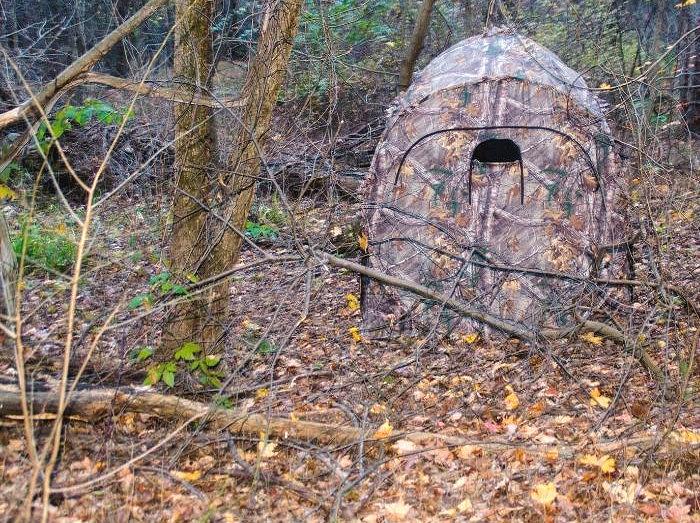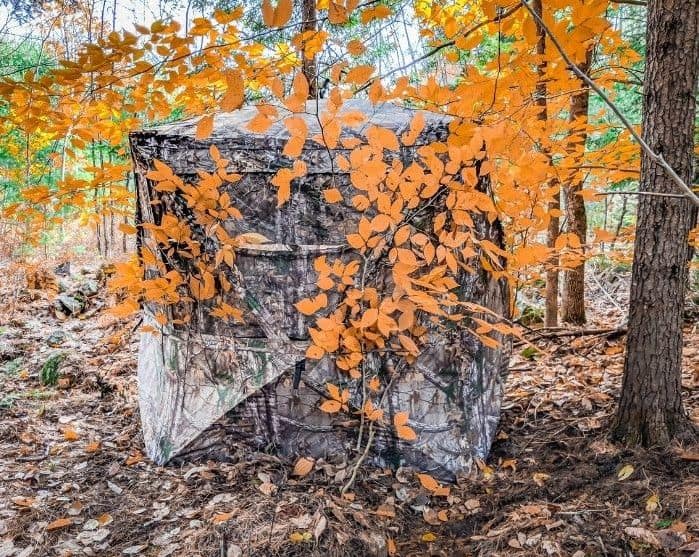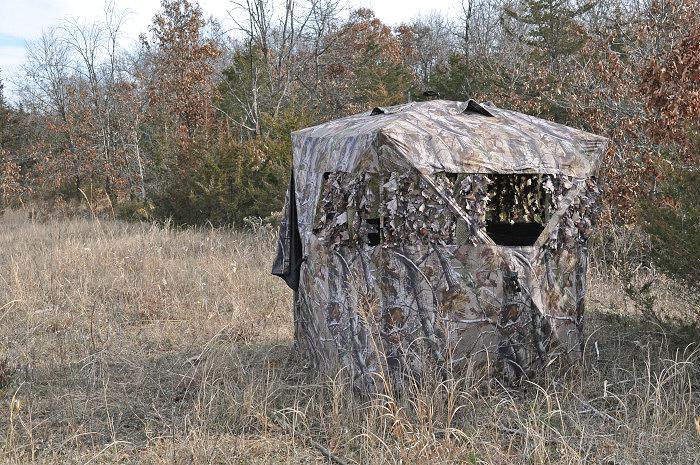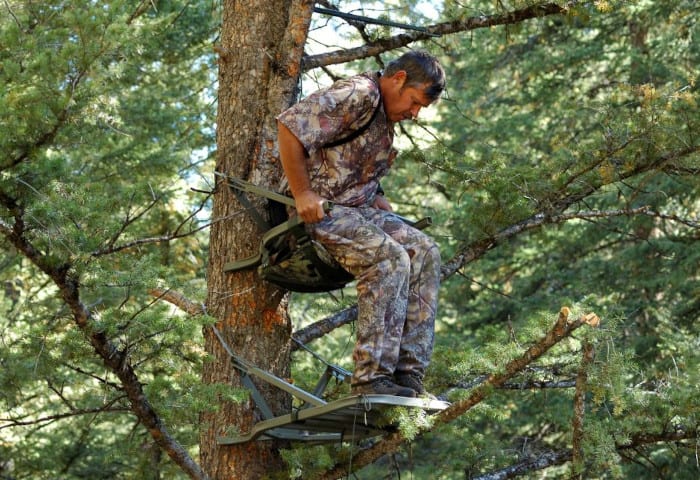So, you found the best spot ever to hunt deer, but, for one reason or another, you can’t or don’t want to hunt from a tree stand. Your most effective alternative option will be using a deer hunting blind. Hunting blinds are either naturally occurring or manufactured hideouts that offer a hunter the capability to hide in plain sight.

Most hunting blinds are commercially manufactured and typically come in one of two formats: an elevated blind (which can also be called a box blind) or a ground blind. Between the two, the ground blind option is generally less expensive, easier to transport or move, and easier to set up or configure.
While ground blinds have several pros and cons, the lower costs and portability factors make them a very popular option in situations where a tree stand isn’t viable. When discussing ground blinds at my full-time job in the outdoor sports industry, prospective customers seem to have several concerns about ground blinds for deer, and one of the most common is this one: how long does it take for deer to get used to a blind?
That’s a tricky question to answer with specifics because, in my deer hunting experience, several factors can play a significant role in the time frame where deer become less and less concerned about a blind being placed in their territory.
Factors that Play a Role in How Quickly Deer Become Accustomed to a Blind
The following factors or conditions are the ones that seem to play the most prominent role in how quickly deer adapt to new ground blinds being set up:
- Blind Type (Elevated Blind or Ground Blind)
- Blind Position
- Blind Concealment Level
- Deer Exposure to Humans
- Blind Scent Control
Let me dive a little deeper into each topic so that I can better explain my reasoning and provide some additional context.
Blind Type (Elevated Blind or Ground Blind)
In the world of hunting blinds, there are predominantly two main types of blinds:
- Elevated blinds
- Ground blinds
Elevated Deer Blind
At the risk of sounding redundant, an elevated blind is one that is positioned off the ground in some manner. This style of blind is different from a tree stand or tree blind as elevated deer hunting blinds (sometimes called elevated deer stands) are NOT affixed to a tree.

This style of blind is typically elevated using either a raised platform, poles, or posts. In the hunting industry, the elevated style blinds have many different names and may also be called:
- Tripod blinds
- Platform blinds
- Box blinds
- Deer blinds
The common denominator with those different names is that the blind itself is elevated off the ground in some way or method.
While this style of blind usually takes more work and effort to set up and can cause more noise and disruptions during the blind set-up, deer seem to acclimate to the elevated blinds reasonably quickly. It usually doesn’t take long before deer go about their own business around an elevated blind set-up.
Ground Blind
As the name implies, ground blinds are designed to be set up or configured on the ground. Ground blinds come in a wide variety of sizes and styles, including pop-up blinds (one of my favorites), tent-style blinds, and chair blinds (which are small blinds built around a hunting chair.

Ground blinds come in different sizes ranging from a single hunter blind up to a 6-person blind. Most commercially produced ground blinds are made from material built to withstand the elements and are lightweight for portability.
Because ground blinds are eye level with a deer, my experience has been that deer take longer to acclimate to a ground blind than an elevated blind.
Blind Position
The location of the blind can also play a role in how quickly deer adjust to the presence of the blind. For example, deer will adapt and accept a blind placed in the edge of a field where they feed faster than a blind placed in the middle of the field.
Blinds that are positioned near large existing objects seem to be less concerning to deer compared to a blind placed in a stand-alone location. For example, a ground blind placed at the base of a large tree will potentially cause less concern for deer versus a ground blind placed in a field edge without any other larger objects to help offset the presence of the blind. Examples of large objects that I’ve previously used to help hide a ground blind are large trees, large rocks, hay bales, stacked bales of straw.
I’ve used ground blinds that looked like a large dead tree, a hay bale, and a rock in hunting situations.
Blind Concealment Level
I mention this factor as the level of concealment associated with a blind can also play a role in how long it takes deer to accept a blind and behave normally.
Brushing in a Ground Blind
One popular technique for ground blinds is to “brush in” or “brush” a blind, and I’ve found this process can speed up the time it takes deer to ignore a blind. This process involves using items common in the area where you are hunting, like tree limbs, branches, reeds, etc., to help camouflage the blind and make it look more like a natural part of the terrain.
I’ve had better success hunting from ground blinds when brushed in or camouflaged than just the blind itself.

I mentioned this previously, but some ground blinds take the concealment to a whole new level by mimicking an everyday item. The two best examples of this I’ve seen so far are dead tree blinds or tree stump blinds which look like a giant old stump, or hay bale blinds that mimic a bale of hay.
Level of Deer’s Exposure to Humans
In my experience, a deer’s level or amount of exposure to humans can also play a role in how quickly they adapt to a newly positioned or set-up deer blind.
Here’s an example I saw firsthand: Several years ago, I was asked to help thin out a herd of deer that were feeding on a neighbor’s garden. The neighbor had tried all the usual deterrents to keep deer out of his garden, including fencing, motion detectors that sounded a loud alarm, a perimeter of foul-smelling materials, etc.
Nothing seemed to be working, and the deer were destroying his garden. When bow season rolled around, he asked if I would come by and harvest a few does from the herd feeding in his garden.
When I came out to meet with the neighbor and go over tree stand positions, it turned out that he did not want me to use a tree stand of any type on his trees. Regardless of me showing him that climbing sticks and saddle stands would not injure or damage the trees, he wouldn’t budge on the issue.
So, I had to figure out a position to place a ground blind that would allow for a safe shot and be close enough to the garden, so the deer were in range.
I picked a spot and set up an Ameristep Doghouse blind because I like the size and ease of use, plus it’s tall enough for me to maneuver my bow freely.
Expecting that the deer would need a bit of time to acclimate, I set up a trail camera on a post near the blind to understand what I was dealing with. I called the neighbor the following week to see if the deer had returned to the garden during daylight hours since I set up the blind. He reported that the deer had returned to the garden to feed after the blind was deployed a day or two. Finding that hard to believe, I pulled the card from the camera and was pleasantly surprised to see that the neighbor was correct. Several deer had returned to feed in the garden within 30 yards of the blind two days after the blind was set up.
This behavior is different from what I’ve typically experienced while deploying blinds in the wild. In most situations, it takes deer anywhere from 2 to 4 weeks to get semi-comfortable with a blind and return to normal activities.
I’m assuming that the close proximity and frequent interaction with humans at the neighbor’s garden led those deer to accept the presence of the blind much faster than deer who have had little contact with people.
Blind Scent Control
Something else that can play a role in how quickly deer adapt to a new blind is the scent control that is used on the blind.
I usually apply some scent control or scent elimination products to any blind that I deploy in an effort to cover up or reduce any strange or new scents that may be associated with the blind. I do this on the inside and outside of the blind and find it seems to speed up the acceptance process with deer.
Obviously, you can’t get rid of all the scent issues associated with a blind, but judging from game camera pics taken over time, it does seem to help when scent control measures are taken when the blind is first set up.
So, How Long Does It Take Deer to No Longer Be Wary of a Blind?
Although the answer can vary based on the above mentioned conditions, I generally try to get blinds (both elevated and ground models) set up and ready to hunt at least four weeks before hunting in one.
While four weeks may not be the exact number for every situation and scenario, I find that four weeks is usually enough time for deer to get used to a blind and return to their routine.
Some hunters prefer a more extended period of time and try to get blinds in place at least 6-8 weeks before hunting season starts. However, I’ve tried longer and shorter periods of time, and the 4-week timeframe seems to work well for me.

FAQS
Here are some other frequently asked questions that I see and hear regarding how deer react to a ground blind:
Will deer notice a ground blind?
Deer almost always are aware of a ground blind when it’s first put in position. In addition to the blind itself, they pick up on the smells and scents associated with the blind as well.
However, as time goes by and the blind just sits there, it becomes another part of the landscape in a deer’s life.
Are deer scared of a ground blind?
When a ground blind is first deployed, it’s an unfamiliar item to deer with a strange set of scents or smells. While they may not specifically be afraid of the blind, it’s something new, so they give a wide berth at first.
As time passes and the blind doesn’t move or appear threatening, deer gradually begin to accept it as a new part of their landscape.

Born and raised in Indiana, Brantley spent his youth chasing deer and turkey and, along the way, developed a passion for bowhunting. Although he still enjoys other types of hunting, his true passion is bowhunting, and he has or will author most all the bowhunting content on this site. Outside of work, Brantley is married and the father of two beautiful little girls. Brantley has worked in the hunting industry, with an emphasis on archery and bowhunting, for more than ten years.



